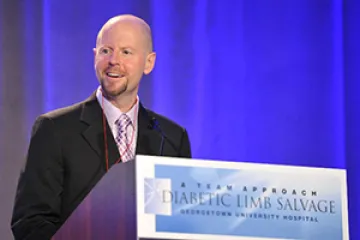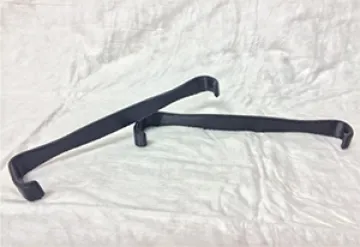3-D Printing and Patient Care: UA Surgeon Shares How the Technology can Saves Lives and Money in The Lancet

University of Arizona professor of surgery David G. Armstrong, DPM, MD, PhD, shared the potential and his lab's current use of 3-D printing in medicine in a recently published article in The Lancet.
3-D printers are used to create three-dimensional objects by depositing material, commonly metal, plastic or ceramics, in successive layers to create a physical object from a digital file. The technology has been used to create car parts, smartphone cases, fashion accessories and even medical equipment and artificial organs.
The Lancet, a UK medical journal, asked Dr. Armstrong, professor of surgery and director of the University of Arizona Southern Arizona Limb Salvage Alliance (SALSA), to share his use and vision of 3-D printing technology in medicine.
The SALSA lab regularly uses 3-D technology to make models for surgical planning before complex operations. The technology allows the clinicians to examine and even touch complicated anatomy to plan strategy before complex surgical procedures. SALSA is a collaborative clinical and research alliance dedicated to advancing care of the diabetic foot and preventing amputations worldwide.
Im evangelical about technology says Dr. Armstrong But Im always asking myself how can we leverage it to help our people If it doesnt work I move on

To understand and apply 3-D technology in medicine, Dr. Armstrong and his team bought a consumer-grade fused deposition manufacturing 3-D printer for about $2,000 and printed Army/Navy retractors, a surgical tool used to pull open shallow or superficial incisions. They printed the retractors with polylactic acid, one of the most basic and readily available filaments. The material cost for each retractor made with the 3-D printer was 46 cents, and when printed under sterile conditions, the team found they were safe and strong enough for use in medical procedures. Dr. Armstrong assessed that the 3-D printed retractors could be used in low-resource settings, or inaccessible areas.
The Lancet article also features Jennifer Lewis, ScD, Hansjorg Wyss Professor of Biologically Inspired Engineering at the Harvard John A. Paulson School of Engineering and Applied Sciences, who describes her goal to print three-dimensional vascularized tissues and ultimately, organs.
The U.S. Food and Drug Administration has cleared the design and manufacture of personalized, anatomically matched implants for use in surgery and in May 2016 issued generalized draft guidance, but the responsibility for appropriate long-term clinical evaluation rests with the individual surgeons and their institutions.
The article's title is The Lancet Technology: 3D printing for instruments, models, and organs To read the full article, please visit: http://www.thelancet.com/pdfs/journals/lancet/PIIS0140-6736(16)31735-4.pdf
About the UA College of Medicine Tucson
The University of Arizona College of Medicine Tucson is advancing health and wellness through state-of-the-art medical education programs, groundbreaking research, and advancements in patient care in Arizona and across the United States. Founded in 1967, the College ranks among the top medical schools in the nation for research and primary care and is leading the way in academic medicine through its partnership with Banner University Medicine, a new division of one of the largest nonprofit health-care systems in the country. For more information, please visit medicine.arizona.edu
About the University of Arizona Health Sciences
The University of Arizona Health Sciences is the statewide leader in biomedical research and health professions training. The UA Health Sciences includes the UA Colleges of Medicine (Phoenix and Tucson), Nursing, Pharmacy and Mel and Enid Zuckerman College of Public Health, with main campus locations in Tucson and the growing Phoenix Biomedical Campus in downtown Phoenix. From these vantage points, the UA Health Sciences reaches across the state of Arizona and the greater Southwest to provide cutting-edge health education, research, patient care and community outreach services. A major economic engine, the UA Health Sciences employs almost 5,000 people, has nearly 1,000 faculty members and garners more than $126 million in research grants and contracts annually. For more information: http://uahs.arizona.edu

